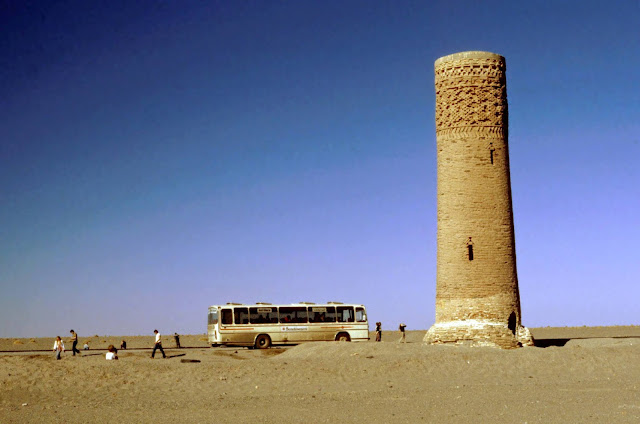 |
| Mil-e Naderi, an ancient route marker in the Dasht-e Lut Desert, Iran |
 |
| The Koh-i Taftan, 4000m volcano in the morning light |
Hopefully formalities will be completed by 10 or 11 (maybe being optimistic) then we can set out, over marginally better roads to the Iranian city of Zahedan. Where we spend the night.
Mon 25 February ZAHEDAN – BAM – KERMAN 523 kms
A long haul today over
roads that are improving. There is a section not far from Zahedan which is
being reconstruction by the British Company Marples-Ridgway which will be a
tremendous improvement when completed.
 |
| Sundowners coach in the Dasht-e Lut Desert, Iran |
|
|
|
|
 |
| The outer walls & the moat of the Citadel, Bam, Iran |
 |
| Arg-e Bam, the mudbrick Citadel of Bam, Iran |
Closer to Kerman, we come across the amazing, fortified town of Bam, said to be the largest abode (mudbrick) construction in the world. Some archaeologist believe the Arg-e Bam, or citadel, could date back to the Achaemenians around 4th century BC, but new fortifications were built by the Sassanids (pre-Islamic Persians) between the 3rd and 7th centuries. Bam, because of its strategic position, became an important stop on the Silk Road and was renown for silkworm breeding. In the 19th century its importance had declined as a caravan stop and it became a military garrison during the Qajar Dynasty of Persian rulers. In 1900, construction of the new city of Bam commenced.
(P.S. On December 26, 2003, Bam was struck by an extremely
destructive magnitude 6.6 earthquake which killed around 26,200 and destroyed
much of this ancient city. UNESCO World Heritage has been instrumental in the ongoing work of reconstructing the
Citadel)
 |
| The walls & fortifications of the Citadel at Bam, Iran |
Another 190kms on good roads will take us to Kerman, the main city in this area of Iran. Near Kerman is a systems of qanats, an ancient subterranean system for transporting water from an aquifer or well to an area of cultivation, a town or garden by way of an underground aqueduct.
 |
| This photo of Ayatollah Khomeini had been slipped under of windscreen wipers on the outward journey |
These water channels are anything upwards of 5kms in length, from 100m to 15m below ground and with access wells every 20-35m. In the early 1950s an expedition from Oxford University travelled to Kerman to study the qanat system. Anthony Smith, a member of the expedition aptly described the qanats in Blind White Fish in Persia, his book on the expedition:. “As with birds before an island, the qanat wells warned you of the approach of a town; they are the ramifying tendrils which are responsible for its livelihood, the arteries of its existence and, as with arteries, their breakdown causes that existence to cease.”
Tue 26 February KERMAN – YAZD - ISFAHAN 680 kms
Early start for the long drive through to the amazing city of Isfahan. The route takes us through the city of Rafsanjan which is the world’s largest producer of pistachio nuts and then on to Yazd, ‘city of the Windcatchers’.
 |
| Windcatchers in Yazd - (Diego Delso - Wikimedia) |
The windcatchers, or wind towers are an architectural feature used to create natural ventilation and passive cooling in buildings. Yazd also has a large Tower of Silence, used by adherents to the Zoroastrian faith upon which they placed their dead in ‘sky burials’. In the Zoroastrian religion, fire and clean water were agents of ritual purity and the dead were placed on these Towers of Silence for excarnation, that is the exposure to the elements for decay in order to avert contamination of the soil. Carrion birds, such as vultures, would consume the flesh and the skeletal remains would be left in a central lime pit. At the moment (1980), the current rulers of Iran are a little touchy about foreigners taking photos of these towers.
Zoroastrianism is one of the world’s oldest continuously practised religions and is based on the teachings of prophet Zoroaster, also known as Zarathustra. Zoroastrianism has a dualistic cosmology of good and evil, and an eschatology predicting the ultimate
 |
| Ahura Mazda |
|
|
text & photographs ©Neil Rawlins |


No comments:
Post a Comment